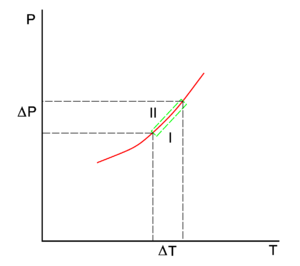Clausius-Clapeyron relation
The Clausius–Clapeyron relation is an equation for a system consisting of two phases of a single compound in thermodynamic equilibrium at constant absolute temperature T and constant pressure P. A curve in a two-dimensional thermodynamical diagram that separates two phases in equilibrium is known as a coexistence curve. The Clausius–Clapeyron relation gives the slope of the coexistence curve in the P-T diagram:
where Q is the molar heat of transition. It is the heat necessary to bring one mole of the compound from phase I into phase II; it is also known as latent heat. For instance, when phase I is a liquid and phase II is a vapor, then Q ≡ Hv is the molar heat of vaporization. Further, V I is the molar volume of phase I at the pressure P and temperature T of the point where the slope is considered and V II is the same for phase II.
The equation is named after Émile Clapeyron, who derived it around 1834, and Rudolf Clausius.
Derivation
The condition of thermodynamical equilibrium at constant pressure P and constant temperature T between two phases I and II is the equality of the molar Gibbs free energies G,
The molar Gibbs free energy of phase α (α = I, II) is equal to the chemical potential μα of this phase. Hence the equilibrium condition can be written as,
which holds along the red (coexistence) line in the figure.
If we go reversibly along the lower and upper green line in the figure, the chemical potentials of the phases change by ΔμI and ΔμII, for phase I and II, respectively, while the system stays in equilibrium,
From classical thermodynamics it is known that
Here Sα is the molar entropy (entropy per mole) of phase α and Vα is the molar volume (volume of one mole) of this phase. It follows that
From the second law of thermodynamics it is known that for a reversible phase transition it holds that
where Q is the amount of heat necessary to convert one mole of compound from phase I into phase II. Elimination of the entropy and taking the limit of infinitesimally small changes in T and P gives the Clausius-Clapeyron equation,
Approximate solution
The Clausius-Clapeyron equation is exact. When we make the following assumptions we may perform the integration:
- The molar volume of phase I is negligible compared to the molar volume of phase II: VII >> VI. In general, far from the critical point, this inequality holds well for liquid-gas transitions.
- Phase II satisfies the ideal gas law
- If phase II is a gas and the pressure is fairly low this assumption is reasonable.
- The transition heat Q is constant over the temperature integration interval. The integrations run from the lower temperature T1 to the upper temperature T2 and from P1 to P2.
Under these condition the Clausius-Clapeyron equation becomes
Integration gives
where ln is the natural (base e) logarithm. We reiterate that for gas-liquid transitions Q is the heat of vaporization.











